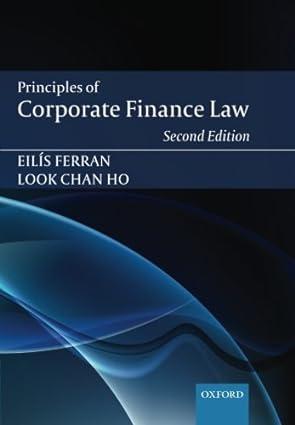Question
The CEO of Nettle plc has approached the directors of Earl Grey plc with an acquisition proposal. It involves a part cash and part shares
The CEO of Nettle plc has approached the directors of Earl Grey plc with an acquisition proposal. It involves a part cash and part shares payment method. All eleven million issued shares would be purchased and all of the net debt of Earl Grey would be taken. In principle, the directors of Earl Grey consider the proposal to have potential. They have stated that this amalgamation would facilitate acceleration of key strategies, stimulate innovation and create new drivers of value. Both Nettle and Earl Grey are leaders within their own niche markets. Nettle has a recent history of M&A activities that clearly indicates an intention to expand operations in this way.
Many observers within the industry have considered previous acquisition prices too high, including a recent deal value of 12 times EBITDA, an industry record. Equity holders of both companies will require various analyses to form expectations of the future for the combined organisation. It is always a concern as to who will benefit in such acquisitions, the target shareholders or those of the acquirer. Empirical evidence exists to support the conclusion that it is the former who win.
The market value of net debt is 17m carrying a 3.5% cost per annum. The corporate tax rate is 25%.
Various risk-measuring services estimate the Earl Grey asset beta to be approximately 1.6. UK government bond yields were offering yields of 2.1%. A recent insight publication recommends a market risk premium of 5 percent, although it emphasises the difficult adjustments to growth forecasts due to the impact of current global circumstances.
The recent Earnings before interest and Taxation of Earl Grey amounted to 4.8m; this included depreciation & amortisation amounting 0.49m. During the year, Earl Grey had capital expenditure of 0.32m and the companys working capital had changed from 3.3m last year to 2.76m this year.
Various forecasts based on historic growth rates suggest that with the potential synergies Earl Grey should be able to achieve an annual 7% growth rate in free cash flows for the next five years. However, other forecasters are more cautious regarding the synergistic effects during the next 5 years. All forecasts agree that the Terminal Value calculation should include an assumed 3% annual growth rate thereafter. For the purpose of the valuation, it would be appropriate to assume a target Debt: Equity ratio of 20:80.
Present an initial pre-acquisition strategic financial focus on this potential acquisition target. Include a Discounted Cash-flow valuation analysis, to advise shareholders on the value attached to the target company. The following elements should be clearly highlighted within your insight document:
1. Make relevant adjustments to the EBIT to derive a cash-flow figure. 8 marks
2. Use relevant models to derive costs of capital. 24 marks
3. Incorporate growth rates appropriately and apply a discounted cash-flow methodology to derive a company valuation. 40 marks
4. Use your result to derive the price per share. 8 marks
5. Identify and discuss what might be key challenges to the Nettle-Earl Grey merger being successful.
Step by Step Solution
There are 3 Steps involved in it
Step: 1

Get Instant Access to Expert-Tailored Solutions
See step-by-step solutions with expert insights and AI powered tools for academic success
Step: 2

Step: 3

Ace Your Homework with AI
Get the answers you need in no time with our AI-driven, step-by-step assistance
Get Started


